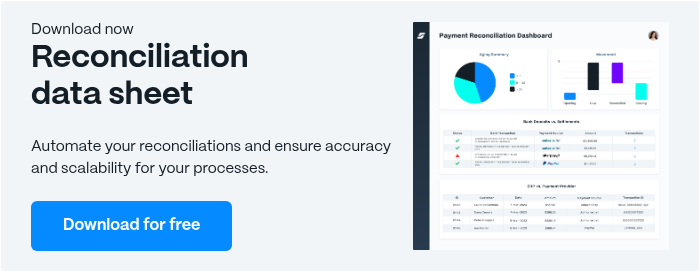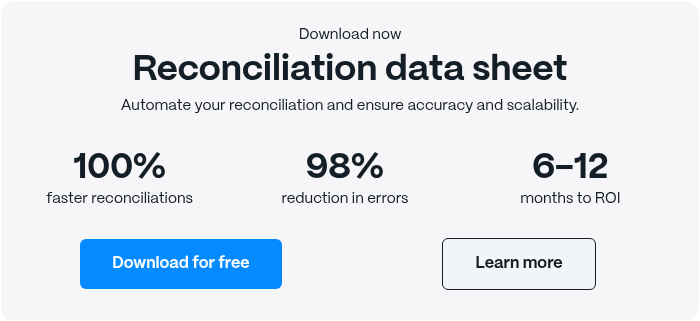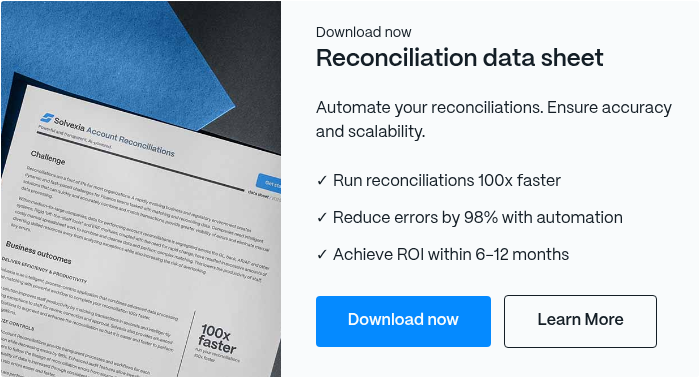Balance Sheet Reconciliation: Full Guide & Best Practices

Balance sheet reconciliation is crucial for every business to perform to understand the company's financial position and make informed decisions accordingly. This essential account reconciliation process ensures financial accuracy, compliance, and helps prevent costly errors that could impact your business.
In this article, we'll explore what balance sheet reconciliation is, its common challenges, and how reconciliation software can save your business time, money, and help to prevent errors.
Coming Up
1. What is Balance Sheet Reconciliation?
2. Importance of Balance Sheet Accounts
3. The Role of Balance Sheet Reconciliation in the Financial Close Process
4. Key Elements of Balance Sheet Reconciliations
5. Balance Sheet Reconciliation Checklist
6. Challenges & Pitfalls of Balance Sheet Reconciliation
7. How to Reconcile a Balance Sheet?
8. Balance Sheet Reconciliation Best Practices & Automation
9. How to Overcome Challenges of Balance Sheet Reconciliation
What is Balance Sheet Reconciliation?
Balance sheet reconciliation is the accounting process of comparing and verifying account balances from your general ledger against supporting documentation and external sources to ensure accuracy and completeness. This critical reconciliation accounting practice involves matching transactions, identifying discrepancies, and making necessary adjustments before finalizing financial statements.
This essential account reconciliation process helps organizations detect errors, prevent fraud, and maintain reliable financial reporting for stakeholders, auditors, and regulatory compliance. Without proper balance sheet reconciliation, businesses risk making decisions based on inaccurate financial data and face potential audit issues.
Balance sheet reconciliation typically occurs at the end of the month, quarter, and/or year as part of the financial close process. Before you set the balance sheet as final, you want to make sure that every transaction is properly categorized and reflected. Balance sheet reconciliation consists of closing these key accounts:
- Accounts payable
- Accounts receivable
- Payroll liabilities
- Accrued liabilities
- Loans and debt
- Cash account
- Prepaid expenses
- Inventory
Importance of Balance Sheet Accounts
Balance sheet accounts are the backbone of a company’s financial statements, offering a clear snapshot of its financial position at a specific point in time. Each balance sheet account—whether it’s cash accounts, accounts payable, or accounts receivable—plays a vital role in reflecting the company’s assets, liabilities, and equity. The balance sheet account reconciliation process is essential for ensuring the accuracy and reliability of this financial data.
Accurate balance sheet accounts empower organizations to identify strengths and weaknesses, make informed investment decisions, and maintain a healthy financial position. Regular reconciliation of these accounts is crucial, as it helps companies detect errors, identify discrepancies, and ensure that all financial records are up-to-date and compliant with regulatory standards.
Ultimately, balance sheet account reconciliation is a critical internal control that underpins a company’s financial reputation and integrity, ensuring that financial statements present a true and fair view of the organization’s financial position.
The Role of Balance Sheet Reconciliation in the Financial Close Process
Balance sheet reconciliation plays a critical role in the financial close process, serving as the final checkpoint before financial statements are finalized and distributed to stakeholders. This essential account reconciliation step ensures that all account balances are accurate, complete, and properly supported before the books are officially closed each month, quarter, or year.
The accuracy achieved through balance sheet reconciliation is crucial for external reporting and stakeholder confidence. Bankers, insurers, investors, and auditors rely on these reconciled financial statements to assess your company's creditworthiness, financial health, and investment potential.
Without proper reconciliation accounting procedures, your business risks presenting inaccurate financial information that could damage stakeholder relationships, impact funding opportunities, and create compliance issues with regulatory requirements.
Key Elements of Balance Sheet Reconciliations
To perform balance sheet reconciliation properly, it’s vital to understand what the key elements of the process include. Here are the essential components of effective account reconciliation:
1. Verification of Balances
Compare the balances in your general ledger accounts to the corresponding balances in your supporting documents. Identify and investigate any discrepancies or unexplained variances, including identifying errors by reviewing transaction records.
2. Documentation
Maintain complete supporting documentation, including payment records, to substantiate the balances and transactions being reconciled.
3. Timeliness
Perform reconciliations on a regular basis (monthly, quarterly, or as required) to ensure that errors are detected and corrected promptly.
4. Review and Approval
Have reconciliations reviewed and approved by someone other than the preparer to ensure accuracy and compliance with internal controls.
Balance Sheet Reconciliation Checklist
Follow this essential balance sheet reconciliation checklist to ensure your account reconciliation process is thorough and accurate:
- Gather All Accounting Documents: Pull together all supporting documentation including bank statements, receipts, invoices, current account balances, and other financial records. This documentation serves as the foundation for your general ledger reconciliation and ensures you have everything needed to verify account accuracy. Many organizations use accounting software to facilitate the collection of documents and automate parts of this process, making it more efficient and less prone to manual errors.
- Compare and Cross-Reference Documents: Systematically compare information from your general ledger against supporting documents and external sources. During this reconciliation accounting process, carefully review each transaction and keep an eye out for inconsistencies, timing differences, or unexplained variances that require investigation.
- Investigate and Make Necessary Adjustments: When you identify discrepancies during your balance sheet reconciliation, investigate the root cause and make the necessary adjusting journal entries. Document all changes with proper supporting evidence and obtain required approvals before posting corrections.
- Verify Your Balance Sheet Balances: Confirm that your total assets equal your total liabilities plus equity—the fundamental accounting equation that ensures your balance sheet is mathematically accurate. This final verification step is crucial before completing your financial close process and finalizing your financial statements.
Automated solutions, such as those offered by Solvexia, can streamline the reconciliation process by automating routine tasks, reducing manual effort, and enhancing collaboration. By leveraging these tools, finance teams can free up resources for value adding analysis, focusing on more strategic and insightful financial evaluations.
Challenges & Pitfalls of Balance Sheet Reconciliation
Manual balance sheet reconciliation presents numerous challenges that can significantly impact your financial close process. Understanding these pitfalls helps you identify areas for improvement and automation opportunities.
Compromised financial integrity can result from errors, omissions, or delays in manual reconciliations. Implementing balance sheet certification and maintaining balance sheet integrity are essential for audit readiness and building stakeholder trust.
1. Time Pressure & Volume Overwhelm
Picture this scenario: you're at the end of your fiscal quarter, struggling to keep up with business pace while manually connecting multiple ERPs, bank transactions, and accounting systems. With high transaction volumes, finance teams face enormous pressure completing reconciliation checklists, processing journal entries, and finding unmatched transactions—all within tight closing deadlines.
2. Excel Spreadsheet Risks
Many businesses rely heavily on Excel spreadsheets, email chains, and basic workflow systems for account reconciliation. This creates significant problems: spreadsheets require manual configuration and data entry, with research showing that nearly 90% contain at least one error. These mistakes multiply as data volume and calculation complexity increase, creating cascading errors throughout your financial statements.
3. Manual Processes & Human Error
Manual reconciliation accounting processes are prone to miscoding, misallocations, and data entry mistakes that can impact the entire general ledger reconciliation. Without automated controls, these errors often go undetected until auditors flag them, causing delays, corrections, and potential compliance issues.
4. Disconnected Systems & Data Silos
Organizations typically pull reconciliation data from multiple disconnected sources—ERPs, subledgers, banking platforms, and third-party applications. This fragmented approach creates data consistency issues, requires extensive manual work to consolidate information, and increases the risk of missing or duplicating transactions.
5. Inadequate Technology Solutions
Not all reconciliation software addresses every business need. Some applications provide basic visibility but still require significant manual effort for preparation and analysis. Others fail to integrate properly with existing systems, creating new inefficiencies instead of solving problems.
6. Compromised Financial Integrity
When reconciliations are incomplete or inaccurate, external auditors flag these as red flags, potentially triggering regulatory scrutiny, stakeholder concerns, and reputational damage. The lack of automated reconciliation capabilities means finance teams spend time on repetitive tasks instead of high-value analysis and strategic planning.
How to Reconcile a Balance Sheet?
Follow this systematic balance sheet reconciliation process to ensure accuracy in your financial close process:
Step 1: Identify Accounts to be Reconciled
Determine which balance sheet accounts require reconciliation based on materiality and risk. Focus on high-impact accounts like cash, accounts receivable, accounts payable, inventory, and loans.
Step 2: Gather Supporting Documentation
Collect necessary documents including bank statements, invoices, aging reports, inventory records, and general ledger reconciliation reports from all relevant sources.
Step 3: Compare General Ledger to Supporting Records
Compare your general ledger balances against supporting documentation and external sources. This reconciliation accounting step involves matching transactions and identifying discrepancies.
Step 4: Investigate and Explain Discrepancies
When variances are found, investigate the root cause—timing differences, data entry errors, missing transactions, or unrecorded fees. Contact vendors or banks as needed to resolve unclear items.
Step 5: Make Adjusting Journal Entries
Prepare and post necessary adjusting entries to correct your general ledger. Ensure all adjustments have supporting evidence and required approvals before posting.
Step 6: Document and Finalize the Reconciliation
Verify adjusted balances match supporting records, create reconciliation worksheets, obtain supervisory approval, and file documentation for audit trails. Confirm that Assets = Liabilities + Equity.
By following these steps, you help produce accurate financial reports, support ensuring financial accuracy, and enable accurate and timely disclosures to stakeholders.
Balance Sheet Reconciliation Best Practices & Automation
Implementing proven balance sheet reconciliation best practices can transform your reconciliation accounting process from a manual, error-prone task into a streamlined, accurate operation:
1. Implement Automated Reconciliation Software
Modern reconciliation software like Solvexia eliminates manual work by automatically matching transactions, identifying discrepancies, and generating reconciliation reports. Automated reconciliation tools improve speed, reduce errors, and free your finance team to focus on analysis rather than data entry.
2. Establish Strong Internal Controls
Create standardized policies for account reconciliation processes, including clear approval hierarchies, segregation of duties, and mandatory review procedures. Document all reconciliation steps and maintain comprehensive audit trails to ensure compliance and facilitate external audits.
3. Conduct Regular Risk Assessments
Apply risk-based approaches to prioritize your balance sheet reconciliation efforts. Focus resources on high-risk, material accounts while implementing lighter controls for low-risk items. Regularly reassess account risk ratings based on transaction volume, complexity, and historical error rates.
4. Integrate with Your Financial Close Process
Align balance sheet reconciliation timing with your financial close process to identify and resolve issues before month-end deadlines. Use reconciliation software that integrates with your ERP system to provide real-time visibility into reconciliation status and outstanding items.
5. Focus on Continuous Improvement
Regularly review reconciliation metrics like completion times, error rates, and resource requirements. Use automation dashboards to identify bottlenecks and process inefficiencies. Train your team on new reconciliation software features and best practices to maximize efficiency gains.
6. Leverage Pre-Configured Templates
Utilize standardized general ledger reconciliation templates and workflows that can be customized for different account types. This approach ensures consistency, reduces setup time, and minimizes the risk of overlooking critical reconciliation steps.
By combining these best practices with robust automation technology, organizations achieve faster, more accurate reconciliations while ensuring compliance and reducing operational risk.
How to Overcome Challenges of Balance Sheet Reconciliation
Transform your balance sheet reconciliation challenges with these proven solutions:
- Implement Automation: Replace manual processes with automated reconciliation solutions that match transactions and identify discrepancies automatically. Reconciliation software eliminates manual data entry, reduces errors by up to 98%, and frees your team to focus on analysis rather than repetitive tasks.
- Establish Systemized Workflows: Create standardized account reconciliation processes with pre-configured tasks and approval hierarchies. Automated workflows ensure each reconciliation step is completed correctly, provide complete audit trails, and accelerate your financial close process.
- Integrate Financial Systems: Connect your general ledger reconciliation with other business applications to eliminate data silos and manual transfers. System integration provides real-time visibility and ensures your balance sheet reconciliation reflects the most current, accurate information across all platforms.
- Invest in Staff Training: Implement comprehensive training programs when introducing new reconciliation software and processes. Proper training ensures maximum adoption, efficiency gains, and helps your team adapt to evolving reconciliation accounting technology and best practices.
These focused solutions enable organizations to achieve faster, more accurate reconciliations while reducing manual effort and operational risk.
Wrap Up
Balance sheet reconciliation can be challenging and error-prone when performed manually, wasting time and increasing financial risk. However, implementing automated reconciliation solutions transforms these workflows into streamlined, accurate processes that save time, reduce errors, and free your team for strategic analysis.
Modern reconciliation software eliminates manual bottlenecks, integrates with existing systems, and provides real-time visibility into your financial close process. The result: faster closes, improved accuracy, and reduced operational risk.
Ready to automate your reconciliation process? Book a demo with Solvexia to see how our reconciliation software can transform your financial close and reduce reconciliation time.
FAQ
How do you reconcile a balance sheet?
Balance sheet reconciliation involves comparing account balances in the general ledger to supporting documents (such as bank statements, invoices, or subledgers) to ensure accuracy. The process typically includes identifying which accounts need reconciliation, gathering documentation, comparing balances, investigating discrepancies, adjusting journal entries, and documenting the results. This ensures that the financial statements reflect the true financial position of the business.
What is the meaning of balance reconciliation?
Balance reconciliation refers to the process of ensuring that two sets of records — usually the company’s internal accounts and external statements or subledgers — are in agreement. It verifies that transactions are accurately recorded, classified, and reflected in the financial statements, helping to detect errors, prevent fraud, and maintain reliable financial reporting.
How often should you reconcile balance sheet accounts?
Most companies reconcile balance sheet accounts monthly, aligning the process with the month-end close. However, depending on the size and complexity of the business, some reconciliations may also be done quarterly or annually. High-risk or high-volume accounts, such as cash or accounts receivable, should be reconciled more frequently to maintain accuracy and reduce risk.
What is the GL (General Ledger) reconciliation process?
GL reconciliation is the process of verifying that all transactions recorded in the general ledger are accurate and complete by comparing them to subledgers or supporting documentation. This includes ensuring that debits and credits match, investigating and resolving discrepancies, and making necessary adjustments. A well-maintained GL reconciliation process supports accurate financial reporting and ensures compliance with accounting standards.
Intelligent reconciliation solution
Intelligent rebate management solution
Intelligent financial automation solution
Intelligent Financial Automation Solution
Intelligent financial automation solution
Intelligent financial automation solution
Intelligent financial automation solution
Intelligent financial automation solution
Intelligent regulatory reporting solution
Free up time and reduce errors
Recommended for you

Request a Demo
Book a 30-minute call to see how our intelligent software can give you more insights and control over your data and reporting.

Reconciliation Data Sheet
Download our data sheet to learn how to automate your reconciliations for increased accuracy, speed and control.

Regulatory Reporting Data Sheet
Download our data sheet to learn how you can prepare, validate and submit regulatory returns 10x faster with automation.

Financial Automation Data Sheet
Download our data sheet to learn how you can run your processes up to 100x faster and with 98% fewer errors.

Financial Automation Data Sheet
Download our data sheet to learn how you can run your processes up to 100x faster and with 98% fewer errors.

Financial Automation Data Sheet
Download our data sheet to learn how you can run your processes up to 100x faster and with 98% fewer errors.

Financial Automation Data Sheet
Download our data sheet to learn how you can run your processes up to 100x faster and with 98% fewer errors.

Financial Automation Data Sheet
Download our data sheet to learn how you can run your processes up to 100x faster and with 98% fewer errors.

Financial Automation Data Sheet
Download our data sheet to learn how you can run your processes up to 100x faster and with 98% fewer errors.

Rebate Management Data Sheet
Download our data sheet to learn how you can manage complex vendor and customer rebates and commission reporting at scale.

Top 10 Automation Challenges for CFOs
Learn how you can avoid and overcome the biggest challenges facing CFOs who want to automate.
.svg)








